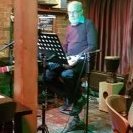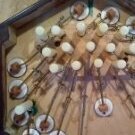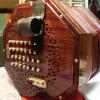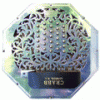-
Posts
1,569 -
Joined
-
Last visited
About John Wild
- Birthday 03/31/1949
Profile Information
-
Gender
Male
-
Interests
I play English Concertina and Hayden Duet. I play solo at local folk clubs, and play in the band with Kettle Bridge Concertinas, a local small ensemble in Mid Kent. Members have mixed ability levels, some very experienced players, and some beginners.
-
Location
Gillingham, Kent. U.K.
Recent Profile Visitors
3,364 profile views
John Wild's Achievements

Heavyweight Boxer (5/6)
-
Thank you. I suppose I should have guessed that.
-
Can I ask what is the meaning of "octo" in the ledger description?
-
Very sad news. I had the fortune to attend concertinas at Witney in a year when Norman Chalmers was the tutor for the English Concertina workshop. He was a hard taskmaster but I did learn from it. Later I had the good fortune to buy a treble concertina from Norman Chalmers, via Ebay. If I remember correctly, he said he was selling it to buy a baritone.
-
You could place another cushion underneath.
-
The tutor that Roger Hare linked to above was compiled by Brian Hayden. It shows layout charts for all the duet systems. The other pages can be applied to all systems.
-
X:743 T:St.Patrick's Day M:6/8 L:1/8 K:G d|:G>AG GBc|d>ed dBG|A>Bc BGD|E>FE E2D| |G>AG GBc|d>ed dBG|A>Bc BGD|E2FG2d:|| |:def .g2.e|.f2.d.e2B|def g2e|f2de2g| |G>AG GBc|d>ed dBG|A>Bc BGD|E2FG2:|| This version of St.Patrick's day was played in the 1959 film A night to remember, about the sinking of the Titanic. It was depicted in a ceilidh scene among the Irish passengers in steerage. From a close up of the fingers, it looks like an actual concertina player, not an actor.
-
Is it possible you can train your body so that your left arm does less work and your right arm becomes dominant in moving the bellows? That may not be easy but may be worth a try. Do you play standing or seated? If standing, perhaps consider playing seated with the left end resting on one knee.
-
40 or 50 years ago would take you back only to 1974. I think the key period could go back another 50 years. As an English concertina player, i have no involvement directly in this debate.
-
This came from a workshop at Broadstairs folk week several years ago, pre-covid. Amelie.pdf
-

Double-extended EC what would you call it?
John Wild replied to Matthew Heumann's topic in General Concertina Discussion
Someone I met a few years ago, on my enquiring, told me his instrument was a treble-baritone. After a few more questions, I identified this as what is more commonly described as a baritone-treble. His definition sounded more accurate to me, but I doubt if that would become an accepted definition now, when baritone-treble is commonly accepted. -
I do not have a hard copy of the book. I found it with a google search at this website: https://ia902209.us.archive.org/32/items/ACollectionOfTheBalladsMelodiesAndSmall-pipeTunesOfNorthumbria/NorthumbrianBallads.pdf
-
I have put into practice what I suggested above, and this is the result. It seems to confirm my suggestion. I have removed the repeat marks after bar 8, as these are not in the version in the book. Individuals can of course insert them if they wish. X:2104 T:Coffee and Tea C:Trad S:Northumbrian Minstrelsy M:4/4 O:England F:England K:G "C"ef|"G"g2 d2 BGdB|"G"Gggf ~g2 ed|"G"g2 d2 BGdB|"D7"Aefg ~f2 ed| "G"g2 dc BG B/c/d/B/|"G"Gggf ~g2 ed|"G"g2 dc BG B/c/d/B/| "D7"Aefg ~f2||ed|"G"BgBg (3def gd|"G"BgBg ~f2 ed|"G"BgBg (3dgf gd|"D7"Aegf gfed| "G"BgBg f/g/f/e/ gd|"G"BgBg ~f2 ed|"G"BgBg f/g/f/e/ gB|"D7"Aefg ~f2||
-
The G at the start of the 1st full bar should be the same length as the G at the start of bar 5. However, that is typed as G4, i.e.twice the length. I think that that double length applies to the other notes in that bar and the similarly affected bars. I cannot explain what has happened here, but I am inclined to think that the writer has made errors in the ABC transcription. If you remove the M:4/4I references, and halve the note length in the affected bars, I think this will give you the correct notation. I have attached here an image of the relevant page from the book. Northumbrian Minstrelsy_P164.pdf
-
When I followed the link the page was missing. It must have been removed already for whatever reason.
-
I have taken the liberty of typing up the full tune in ABC from Dougie MacLean's book. I hope this is O.K. X:10 T:Gael, The C:Dougie MacLean S:Dougie MacLean - Tunes, available from www.dougiemaclean.com M:6/8 L:1/8 K:G |:EEE cBA|BAG AFD|EEE cBA|BAG AFD| EEE BAB|dBB BAB|GGG BAB|dBB BAB| Bcc cBc|dcc cBA|ABB BAB|dBB BAG| ABA AGA|cBA EAA|A/A/AA AGA|cBA BAG:| |:ggg eAA|aAA eAA|ggg eAA|aAA eAA| BBB dBB|gBB dBB|BBB dBB|gBB dBB| Bcc cBc|dcc cBA|ABB BAB|dBB BAG| ABA AGA|cBA EAA|A/A/AA AGA|cBA BAG:| W:Last time through, extend last G to finish.









